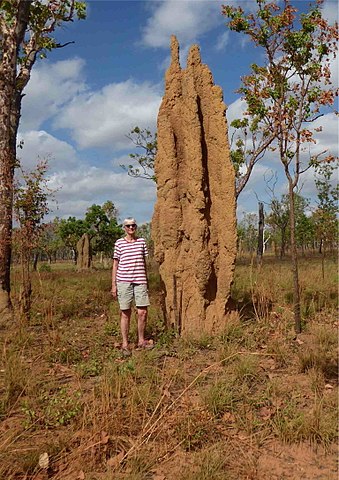 The Eastgate Center in Harare, Zimbabwe is the largest commercial building in the country. Yet, it consumes 90% less energy than the similarly sized building next to it.
The Eastgate Center in Harare, Zimbabwe is the largest commercial building in the country. Yet, it consumes 90% less energy than the similarly sized building next to it.
How is this possible? Well, the Eastgate Center was built to mimic the structure of termite mounds.
In the 1990s, architect Mick Pearce was tasked with designing an energy efficient shopping center for the country of Zimbabwe. Inspired by fungus-farming termite mounds, Pearce designed the Eastgate Center with ducts that channel air inward and chimneys that remove heat by moving it up and out to cool the building.
Termite Skyscrapers!
 When we think of termites, we usually imagine them in wooden structures. But there is another group, the "mound-building" termites, that are found in Africa, South America, and Australia.
When we think of termites, we usually imagine them in wooden structures. But there is another group, the "mound-building" termites, that are found in Africa, South America, and Australia.
These termites create structures as tall as skyscrapers -- well, by termite standards! The mounds can be up to 30 feet tall and have intricate tunnels and chambers. The worker termites build and repair the mound, serve the queen whose only job is to lay eggs, store food (wood) and tend to the fungal gardens. Termites eat fungus, which in turn helps them digest the wood.
However, it is the structure of the mound that has captivated scientists. It was assumed by scientists like Mick Pearce that termite mounds regulate temperature through a system of convection currents. A convection current is created when less dense, warm air rises and more dense, cool air sinks. This creates a movement of air as cool air enters following the exit of warm air.
A New Discovery
 However, a recently published study in the Journal of Science Advances indicates termite-mound cooling is much more complex.
However, a recently published study in the Journal of Science Advances indicates termite-mound cooling is much more complex.
Dr. Kamaljit Singh and his colleagues noticed that while fungus-farming termite mounds have ‘ducts’ and ‘chimneys’, African termite nests seemed to be completely enclosed. this raised the question -- how is cooling achieved in these closed mounds?
The team examined African termite nests at a microscopic level and found a tiny network of interconnected large and small pores. The pores are made by stacking pellets of sand mixed with spit and soil. They also found that these pores are consistent in termite mounds, regardless of if the mound is made of sand, clay, or other materials.
Through further experiments, they found that the pores mainly function as an exchange system for carbon dioxide and oxygen. They compare the termite mound ventilation system to gas exchange in our lungs. When lung muscles contract, they allow oxygen to diffuse and enter the bloodstream and which is then circulated around the body. Similarly, when the wind blows against the mound, gasses diffuse through the pores allowing oxygen to reach deep into the nest, sustaining the termite population.
After this discovery, the Eastgate center was examined again. Now, it is realized that the cooling system functions so well because Pearce used porous concrete slabs that act as heat sinks, storing thermal energy during the hot day and releasing it during cool nights-- just like the termite mounds!
Isn't it amazing how scientists can solve the most complex problems by observing the natural world around them!
Sources: Harvard, NYTimes, biologists.org, nautil.us







